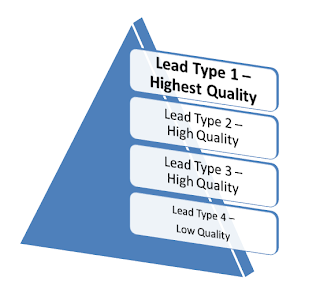Lead Generation itself has recently morphed into growth hacking -- finding new sources and channels for high quality leads and nurturing lower quality ones into opportunities that indicate "near-buying" behavior.
NO MORE COLD CALLING! Today, marketing can completely relieve the sales team from majority of lead gen tasks, such as cold calling, dialing for leads, "pounding the phones," etc. The idea is to get prospects educated and sold online - before they even speak with a sales rep.
Unlike the interrupt-driven outbound model, by implementing inbound marketing, you are reaching a completely different type of prospects. These prospects are more qualified, since they have a specific need and they are actively looking for a solution. By providing them a variety of relevant tools and information, you are helping in their decision-making process. By the time they decide to contact you, they are well educated on the product and are most likely willing to take the next step. Contrast that with a sales rep cold calling and trying to pitch a product to people that don't have a problem they are trying to solve in the first place.
Implementation. This approach significantly shortens sales cycles, increases conversion rates and drives down cost of each sale. But how do you implement it? The first step is lead classification -- understanding what are the most and least desirable leads, as well as all types in between. Here are some recommendations:

1. Lead Types. Find out what kind of leads are you getting today. For example:
- Demo Requests
- Free Trials
- Phone calls
- White paper downloads
- Email contact requests
Brainstorm with your sales team to see what works for them best and worst, as well as what other types of leads you may want to be getting moving forward.
2. Analytics. Look at your metrics for the last 12 or 24 months. Even though you can build some very complex models, I would start with basics:
- Conversion rates - lead to opportunity, opportunity to deal, lead to deal
- Time to conversion - same as above
- Costs - per lead, per opportunity and per closed deal
- Effort - how much time does your sales team invest in converting these leads?
3. Trends and scalability. How did these numbers change over time? Can you grow them easily? Would scaling costs be linear or would they require a significant investment -- to take to the next level? Can your marketing team handle the growth (team size, budgets, skills)?
 4. Pyramid Map. Next, build a pyramid like the one on the left, as a visual representation of types of leads you are going after.
4. Pyramid Map. Next, build a pyramid like the one on the left, as a visual representation of types of leads you are going after.5. Lead Inclusion / Exclusion. Decide on which types of leads you are going to focus moving forward. At this point, you may decide that some types of leads are too expensive. You may find out that some low quality leads are even not worth pursuing due to the effort required.
For example, after this type of analysis, we have decided that leads generated by an outsourced lead generation agency were too expensive and required too much effort from our sales team, making them completely ineffective in comparison with other lead types. Instead, we shifted our focus on higher quality leads that required significantly less effort from our sales team.
6. Planning. Once you have the lead metrics, analysis, lead map and your sales plan, it is very easy to put together weekly, monthly and quarterly plan of how many and what type of leads you need. Knowing the cost per lead and conversion percentages will help you accurately forecast marketing budgets - in terms of their size and timing.
7. Metrics. Finally, I suggest monitoring lead metrics daily, weekly, monthly, quarterly and annually - to measure how you are executing against the plan. Sometimes, you may need to to adjust activities - due to market changes, competitive moves, opportunities, etc.
You can add more advanced metrics later, like lead scoring, heat map, etc. But it is critical to intimately understand the effectiveness of each lead type before implementing these, otherwise lead scores are useless and the sales team will stop taking them seriously.
We have created a daily lead generation report that gets emailed to marketing, sales and relevant executives at the end of each business day. This report covers number of leads in each category, broken down by source, type, relevant lead details, etc. The same group of people receives a weekly lead composite report that looks not just at weekly numbers, but weekly and monthly trends in each category, enabling us to discover very interesting and useful micro and sometimes macro trends.
In my next blog entry in CMO Guide to Inbound Marketing, I will discuss the lead gen mix: outbound vs. inbound.
.jpg)